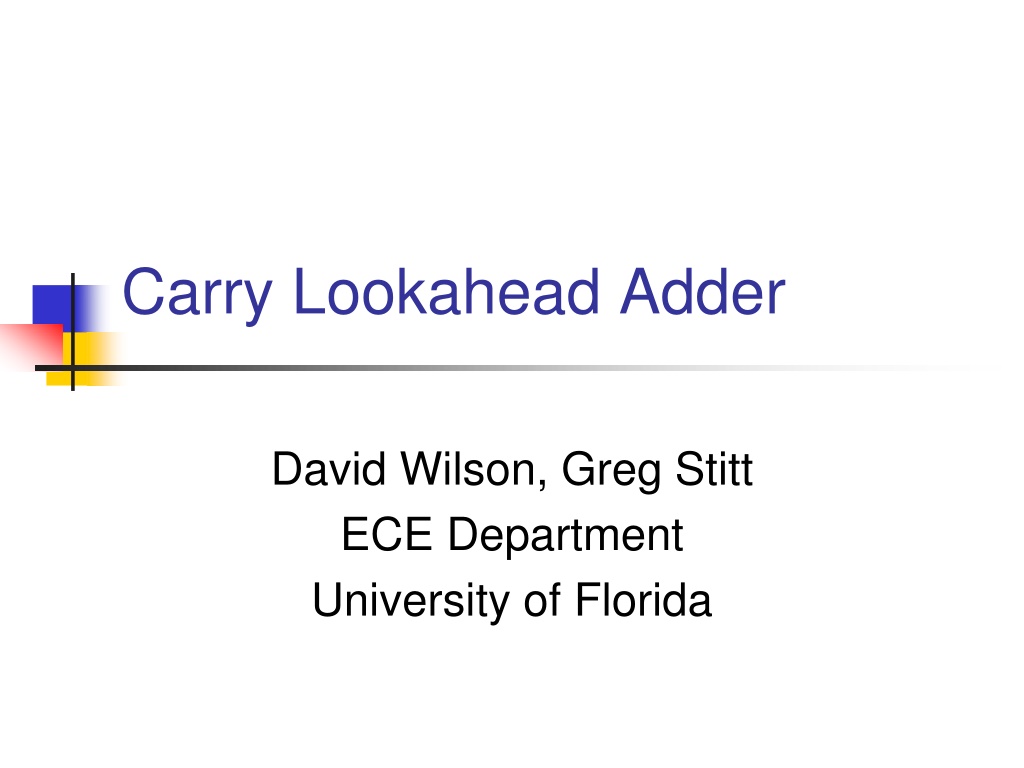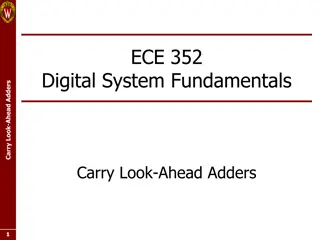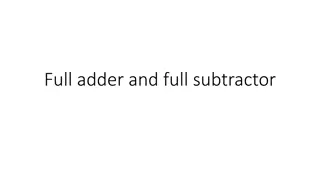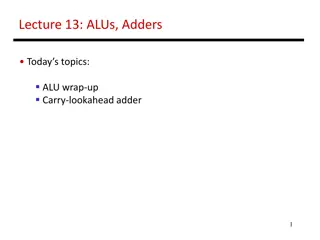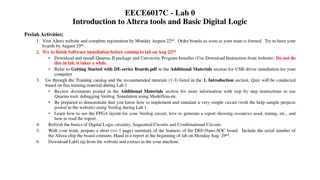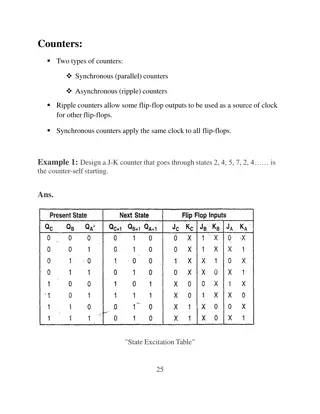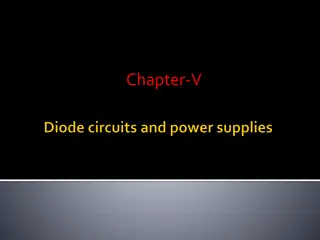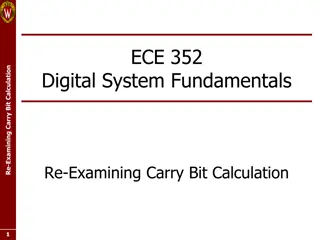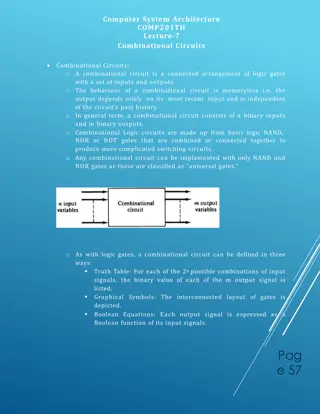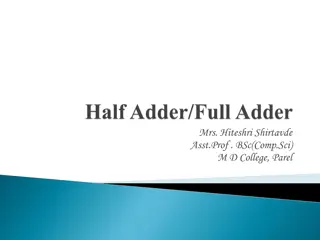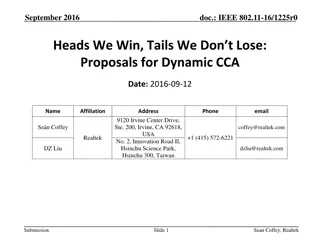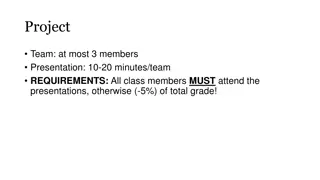Understanding Ripple Carry Adder in Digital Design
Implementing digital functions involves considering tradeoffs. Explore different adder architectures like the Ripple Carry Adder, which grows linearly in area and delay with bit width. Discover its advantages, disadvantages, and the quest for an adder with constant delay. Dive into carry dependencies and equations to enhance your digital design knowledge.
Download Presentation

Please find below an Image/Link to download the presentation.
The content on the website is provided AS IS for your information and personal use only. It may not be sold, licensed, or shared on other websites without obtaining consent from the author. Download presentation by click this link. If you encounter any issues during the download, it is possible that the publisher has removed the file from their server.
E N D
Presentation Transcript
Carry Lookahead Adder David Wilson, Greg Stitt ECE Department University of Florida
Introduction There are many ways to implement a digital function, but each approach may have different tradeoffs As a digital designer, you need to consider these tradeoffs when meeting design requirements As an example, we ll look into different adder architectures Read Section 5.4 for more details
Ripple Carry Adder Y X Cin Full Adder x y cin ? = ? ? ??? FA ????= ?? + ????+ ???? cout S Cout S Ripple Carry Adder A ripple carry (RC) adder is a series of full adders connected by the carry bit Y3 X3 Y2 X2 Y1 X1 Y0 X0 C0 FA3 FA2 FA1 FA0 C3 C2 C1 C4 S3 S2 S1 S0
Advantage: Area Impact The ripple carry adder s area grows linearly with bit width Y3 X3 Y2 X2 Y1 X1 Y0 X0 C0 Area (# of gates) C3 C2 C1 FA3 FA2 FA1 FA0 C4 S3 S2 S1 S0 Width Each additional bit adds another full adder and its associated gates
Disadvantage: Delay Impact The ripple carry adder s delay also grows linearly with bit width Y3 X3 Y2 X2 Y1 X1 Y0 X0 C0 C3 C2 Delay C1 FA3 FA2 FA1 FA0 C4 S3 S2 S1 S0 Width Each full adder must wait for the previous full adder to produce outputs Lower performance with bit width!
Delay Problem Ideally, we want an adder that has constant delay for any width Can we remove the dependence on the previous stage to avoid cascaded delays?
Carry Dependency The carry equation in the RC adder is: ??+1= ????+ ????+ ???? Each carry signal is dependent on the previous carry signal Carry signal ripples across full adders Can we determine the previous carry ahead of time? Y X Cin Y X Cin FA FA Cout S Cout S
Another Look at Carry Equations Can be factored as: ??+1= ????+ ??+ ???? Can be rewritten as: ??+1= ??+ ???? ??= ???? ??= ??+ ??
Generate/Propagate New carry equation: ??+1= ??+ ???? Two behaviors observed: A full adder generates a carry when both inputs are 1 (i.e. ??= ????) A full adder propagates a carry when either input is 1 (i.e. ??= ??+ ??)
Generate/Propagate Example Example: 0001 + 1011 Generate signals (??= ????) FA0generates a carry (?1) 1 0001 +1011 0 Propagate signals (??= ??+ ??) FA1asserts its carry (?2) by propagating FA0 s carry (?1) 11 0001 +1011 00 0011 0001 +1011 1100 FA3would assert its carry (?4) by propagating FA2 s carry (?3) if ?3was asserted
Carry Substitution The new carry equation: ??+1= ??+ ????, or ??= ?? 1+ ?? 1?? 1 With substitution ??+1= ??+ ???? 1+ ?? 1?? 1 ??+1= ??+ ???? 1+ ???? 1?? 1
Removing Dependencies Substituted carry equation: ??+1= ??+ ???? 1+ ???? 1?? 1 The carry signal is now determined by an earlier adder stage s carry! ??+1 is dependent on ?? 1, instead of ?? ??+1 is asserted when: 1. The current stage generates a carry (??) 2. The current stage propagates a carry from the previous stage (???? 1) 3. The current and previous stages propagate a carry from an earlier stage (???? 1?? 1)
Removing Dependencies The increasing delay occurs because each adder stage is dependent on the previous stage Can we remove this dependence through substitutions?
Carry Pattern Carry Equation: ??+1= ??+ ???? Substitutions: ?1= ?0+ ?0?0 ?2= ?1+ ?1?1 ?2= ?1+ ?1??+ ???? ?2= ?1+ ?1?0+ ?1?0?0 ?3= ?2+ ?2?2 ?3= ?2+ ?2??+ ????+ ?????? ?3= ?2+ ?2?1+ ?2?1?0+ ?2?1?0?0
New Carry Dependence Through substitution, every carry signal can be a function of solely c0, g, and p Each carry signal now has the same number of logic levels regardless of width! Example: ?3= ?2+ ?2?1+ ?2?1?0+ ?2?1?0?0 Logic Levels Produce ?? and ?? terms from ?? and ?? Produce carry minterms (e.g. ?2?1, ?2?1?0, and ?2?1?0?0) Produce carry term from minterms
Carry Lookahead Adder Textbook illustration of first two stages in carry lookahead (CLA) adder Second stage s carry is determined concurrently with the first stage s carry propagate/generate terms carry minterms carry term Figure 1. The first two stages of a carry-lookahead adder [1]
Constant Delay The propagation delay is now constant, even as the adder width increases! Each of the CLA adder stages calculate its outputs concurrently Delay RC CLA Width
But at what cost? Area now grows quadratically with width Propagate/generate logic grows with each stage ?2= ?1+ ?1?0+ ?1?0?0 ?3= ?2+ ?2?1+ ?2?1?0+ ?2?1?0?0 ?4= ?3+ ?3?2+ ?3?2?1+ ?3?2?1?0+ ?3?2?1?0?0 Area (# of gates) RC CLA Width Not practical for larger adders
Can we do better? We know of two adders with different advantages as width increases The ripple carry s area grows linearly, but suffers from linear growth in delay The carry lookahead s delay is constant, but suffers from quadratic growth in area Could a hybrid approach limit both area and delay growth?
Alternative Hybrid Approach Make a ripple carry architecture out of multi-bit CLAs adders (or CLA blocks) Y15-12 X15-12 Y11-8 X11-8 Y7-4 X7-4 Y3-0 X3-0 C0 4-bit CLA3 4-bit CLA2 4-bit CLA1 4-bit CLA0 C12 C8 C4 C4 S15-12 S11-8 S7-4 S3-0
Area Impact The hybrid adder s area grows linearly Additional bits add another CLA adder and its associated gates Slower area growth than pure CLA Y15-12 X15-12 Y11-8 X11-8 Y7-4 X7-4 Y3-0 X3-0 C0 Area (# of gates) 4-bit CLA3 4-bit CLA2 4-bit CLA1 4-bit CLA0 C12 C8 C4 C4 S15-12 S11-8 S7-4 S3-0 Width RC CLA Hybrid
Delay Impact The hybrid adder s delay grows linearly Each CLA adder must wait for the previous CLA adder to produce outputs But no longer on a bit-by-bit basis! Lower delay growth than pure RC Delay Y15-12 X15-12 Y11-8 X11-8 Y7-4 X7-4 Y3-0 X3-0 C0 Delay 4-bit CLA3 4-bit CLA2 4-bit CLA1 4-bit CLA0 C12 C8 C4 Width C4 S15-12 S11-8 S7-4 S3-0 RC CLA Hybrid
Alternative Hierarchical Approach In the hybrid approach, we use the RC architecture on multi-bit CLA adders Can we use the CLA architecture on multi-bit CLA blocks? Why would this be beneficial? How does propagate/generate logic work using blocks?
Another Look at Carry Equations Carry equation for 4-bit CLA block: ?4= ?3+ ?3?2+ ?3?2?1+ ?3?2?1?0+ ?3?2?1?0?0 Can be rewritten as: ?4= ?0+ ?0?0 ?0= ?3+ ?3?2+ ?3?2?1+ ?3?2?1?0 ?0= ?3?2?1?0
Hierarchical Generate/Propagate New carry equation: ?4= ?0+ ?0?0 Two behaviors observed: A 4-bit CLA blockgenerates a carry regardless of ?0 (i.e. G0= ?3+ ?3?2+ ?3?2?1+ ?3?2?1?0) A 4-bit CLA blockpropagates a carry when the individual bits propagate ?0 (i.e. P0= ?3?2?1?0)
Hierarchical Substitutions With four 4-bit CLA blocks, ?4= ?0+ ?0?0 ?8= ?1+ ?1?4 ?8= ?1+ ?1(?0+ ?0?0) ?8= ?1+ ?1?0+ ?1?0?0 ?12= ?2+ ?2?8 ?12= ?2+ ?2?1+ ?2?1?0+ ?2?1?0?0 ?16= ?3+ ?3?12 ?16= ?3+ ?3?2+ ?3?2?1+ ?3?2?1?0+ ?3?2?1?0?0 Similar to regular CLA substitutions
Hierarchical Carry Dependence Every block carry signal can be a function of solely c0, G, and P Each carry signal now has the same number of logic levels regardless of width! Example:?12= ?2+ ?2?1+ ?2?1?0+ ?2?1?0?0 Produce ?? and ?? terms from ?? and ?? Produce carry minterms (e.g. p3?2?1, ?3?2?1?0, etc..) Produce ?? and ?? terms carry minterms Produce block minterms (e.g. ?2?1, ?2?1?0, and ?2?1?0?0) Produce carry from block minterms Same as before Same process but with blocks
Hierarchical CLA Textbook illustration of hierarchical CLA using four 8-bit CLA blocks Figure 2. A hierarchical carry-lookahead adder [1]
Multi-level Hierarchical Approaches Previous slides showed a couple of two- level hierarchical approaches RC architecture using CLA blocks CLA architecture using CLA blocks We can add additional hierarchical levels for different area/delay tradeoffs E.g. Three-level CLA Architecture CLA architecture using blocks of a CLA architecture using CLA blocks
Practical Limitations At larger bit-widths, the carry equations requires gates with many inputs Fan-in limits the number of inputs on a gate A network of smaller gates can be used to avoid fan-in at the cost of additional delay Ideally Practically
Practical Limitations For the CLA, delay is practically not constant due to fan-in Larger adders will need networks of gates to handle fan-in in complex carry equations Still lower delay than RC Adder Delay Width RC CLA Practical CLA
References 1. Stephen Brown and Zvonko Vranesic. 2004. Fundamentals of Digital Logic with VHDL Design with CD-ROM (2 ed.). McGraw-Hill, Inc., New York, NY, USA.
